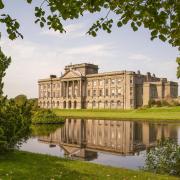The Welsh village of Llanrhaeadr-yn-Mochnant lies nine miles west of Oswestry and 12 miles south of Llangollen. Near to the foothills of the Berwyn mountains stands the Norman church of St Dogfan. The church, built in the 1200s, was dedicated to a Welsh prince also known as Doefan, saint and martyr of the fifth century.
Dogfan was the son of Brychan Brycheiniog, a prince of Powys who became a missionary in the region. Legend has it that Dogfan was put to death by Anglo-Saxon invaders in Pembrokeshire.
The church, founded as a Celtic monastery, is sited on the southern edge of the village, which was once the administrative centre of the province of Powys Fadog Province.
During Victorian restorations of the church in the 19th century a Celtic wheel cross carved upon a stone slab probably once used as a coffin lid and probably dated to the ninth or tenth century, was found within a wall. The restoration transformed the church at a cost of £1,778.
This ancient church is best known today for its vicar between the years of 1578 and 1595, William Morgan, who became Bishop of Llandaff in 1595.
Inside the church stands a life-size wooden statue of the cleric holding his bible. William Morgan was born at Tŷ Mawr Wybrnant close to Betws-y-Coed and he was educated at St John’s College Cambridge. During his time as vicar at St Dogfan’s, he took on the task of translating the first complete version of the Bible into Welsh. His parishioners were most displeased with his actions and accused their vicar of neglecting his duties. William was summoned by the Archbishop of Canterbury over the matter. However, the archbishop was so impressed with the work William had undertaken that instead of chastising him for neglecting his parishioners he made him his own chaplain and gave him the funds and support to allow completion of the translation.
In 1601, William Morgan was granted the Bishopric of St Asaph, a position he held until his death on September 10, 1604.

From 1747 to 1778, the vicar of St Dogfan’s was William Worthing, known for helping create a road from the village to the Pistyll Rhaeadr waterfall four miles away, making visiting the area much easier. Today the church remains open on a daily basis to visitors who travel from all over the country to this very popular tourist area.
The area surrounding the village has many other worthwhile historical places of interest to visit. Just a short distance outside of the village you will find the aforementioned waterfall with its stunning rock formations. Pistyll Rhaeadr is fed from streams flowing down from the Berwyn mountains. The fall descends in three stages to a distance of 240 feet and is classed as the tallest in Wales. At the bottom of the falls the water forms the start of the river known as Afon Rhaeadr. The site is classed as one of the 'Seven Wonders of Wales' and is a site of Special Scientific Interest. A pathway is available for those brave enough to ascend the 240 feet to view the waterfall from above and enjoy the spectacular views.
My film shot at St Dogfan’s, along with many other local history films featuring historical locations around Cheshire and beyond can be viewed at youtube.com/@Tvpresenter4history.
Look out for
Life-size carved statue of William Morgan standing inside the church
Celtic, carved stone wheel cross dated to the 9th to 10th century inside the church
Visit Pistyll Rhaeadr waterfalls to see the 240-ft drop over stunning rock formations



























